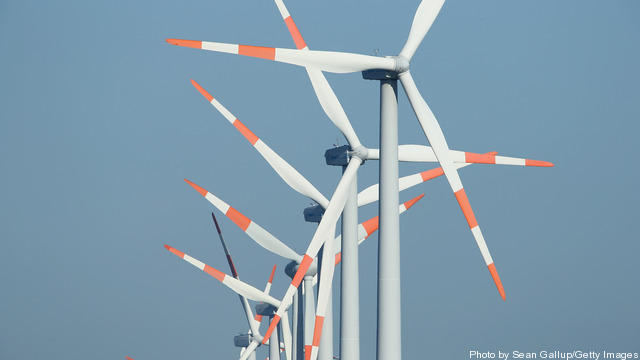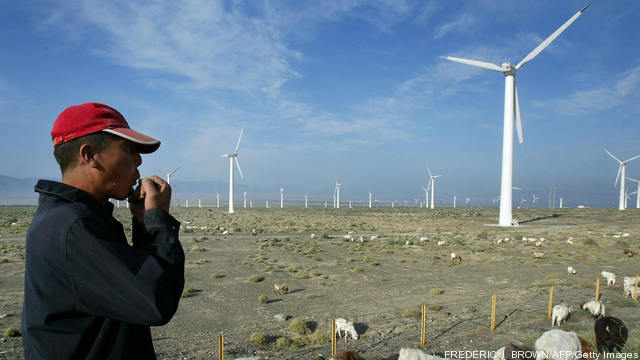
The wind industry has a deal for lawmakers: they’re willing to sacrifice their tax credit for deficit reduction, as long as it’s not snatched away too quickly. Wind turbine makers say they’re OK with an industry plan to gradually phase out its tax credit as part of the fiscal cliff discussion — provided lawmakers extend it for another six years. The wind industry has been fretting that its tax credit – which covers about 30% of the cost of wind power — won’t be renewed when it expires at the end of 2012. The industry says up to 37,000 jobs are on the line if the credit expires. In a bid to prevent that from happening, the American Wind Energy Association said last week that the industry can compete against other power sources like coal and natural gas by 2018, so long as the credit doesn’t disappear before then.
Wind Rush
Sign up and get Breaking Energy news in your inbox.
We will never sell or share your information without your consent. See our privacy policy.
Denmark has been a European haven for cleantech companies seeking to install new renewable energy infrastructure. As other European countries have labored under the impacts of an economic slowdown rooted in a currency and sovereign debt crisis, Denmark – still outside the eurozone if closely linked to it – has remained comparatively committed to ambitious clean energy goals.
Situated on a windy peninsula that divides the North and Baltic seas, Denmark has turned to wind power as an obvious mechanism for building out its clean energy capacity. Huge windmills turning serenely along the water are a feature of the above video, as are interviews with a number of officials, energy industry executives and politicians attending a recent European Wind Energy Association meeting. Keep reading →

Fear for the future amid the plenty of the present characterized the wind industry in 2011.
The US wind power business is only just getting started with 43,461 MW of installed capacity as of the end of September 2011–3.25% of the country’s electricity–and more than 8,400 MW under construction. Keep reading →

Indications that fierce competition in the global wind turbine industry is about to intensify came with news from the world’s largest wind turbine manufacturer. Vestas abandoned its forecast of €15 billion in revenues in 2015 and said that job losses and restructuring will follow instead.
The Danish manufacturer’s third quarter results signal the challenges ahead as established players seek traction in emerging markets to compensate for oversupply, market expansion slows and the US and EU face potential double dip recessions, just as Chinese companies entice overseas customers with knock-down prices. Keep reading →
2010 marked a pivotal year both for global turbine manufacturing capacity and installed capacity around the world.
Global wind turbines saw a record 39.9 GW delivered in 2010. Although leader Vestas saw its market share increase to 14.7% last year also marked a shift as Chinese manufacturers increased deliveries. Sinovel, Goldwind, and Donfang have increased their combined market share by nearly 6% annually on average up to 27% in 2010. Keep reading →

European wind companies have played a major role in the development of the US wind energy sector, even as shadows loom over the industry and the global economy.
Vestas, the world’s largest turbine manufacturer, clearly has high hopes for its US business, with a market share of 18.7% and room for growth. In recent years Vestas had invested in two blade factories, a nacelle facility and a tower facility in Colorado. It also has R&D hubs in Texas, Massachusetts and Colorado. Keep reading →

How the renewable energy industry copes with the loss of incentives this year will test its maturity and the success of the stimulus funding.
In many ways, the renewable energy industry is facing a pivotal moment as the 1603 grant program is set to expire this year, the $2.3 billion for the 48C advanced manufacturing tax credit has already been allocated and the Department of Energy has completed its work of handing out more than $36 billion in its loan guarantee program. Keep reading →

Hundreds of millions of federal dollars from a flagship clean energy grant program were awarded to projects that were well under way before Barack Obama was inaugurated, despite the aim of the 1603 grant program to “primarily” stimulate new projects.
“When the financial crisis hit many developers found that they didn’t have the tax liability that would allow them to claim the credits, so the program was developed to offer an alternative way to continue to incentivize renewable energy development,” a Treasury spokeswoman said. “So, the 1603 program was primarily meant to incentivize new renewable energy projects, but it also supported some existing investments.” Keep reading →

China’s success in building a domestic wind industry has turned it into a victim of its own success. Domestic and global oversupply has pushed Chinese companies into an aggressive price war that extends the shadow of Solyndra to the wind sector.
Companies from China and other Asian countries such as Japan’s Mitsubishi and South Korea’s Samsung are now reaching previously untapped markets such as Bulgaria, Belarus and Macedonia as well as debt-laden European countries such as Ireland and Greece. Keep reading →

If the US wind industry were a patient, any doctor would give it a clean bill of health… until the end of 2012. The prognosis for 2013 could be near-terminal as the Production Tax Credit is due to expire at the end of 2012.
“The goal of the tax credit: is the more we build the cheaper it will become. That has been borne out over time,” says Richard Caperton, a senior policy analyst with the energy opportunity team at Center for American Progress. “Wind is a very healthy industry that is viewed as a mainstream investment by utilities. It’s been very effective.” Keep reading →
